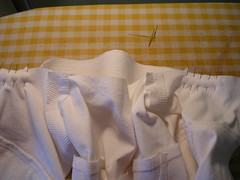
Once I have the collar pinned to the jacket, I confess I don’t baste it like the instructions say. I just lay the facings on top of the jacket and collar combo and pin them to the whole thing. At points, I am pinning through four layers of thick fabric, not including the interfacing and it is tough to get those pins in.
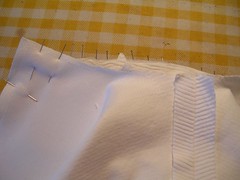
Once I have the whole thing pinned, I look at the top side and the underside where I am going to sew, to see where I may run into difficulty in having the fabric fold over and get caught in tucks that are unintended. Around the shoulder seams, there is more fabric to work into the seam and I know I will have to sew slowly and smooth the fabric top and bottom just before I get to it with the machine needle. I will also take pins out as I go because I have to make the machine work hard to get through all those layers of fabric and if I step on the gas hard when the needle comes down and hits a pin, I know I will break something. For example, at the shoulder seam, I will sew through 6 layers of corduroy and two of interfacing.
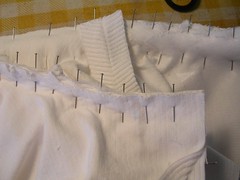
Once the collar is sewed on, I trim the seams and turn things right side out. Lots of pressing and pounding with the clapper later, I can sew two lines of topstitching around the front edges of the jacket. Now it’s time to sew the yoke facing to the jacket. I have already ironed up the seam allowances for the yoke and the jacket back. I trimmed them a little bit too. Next, I smooth the yoke facing down and fold the raw edge under to finish the inside.
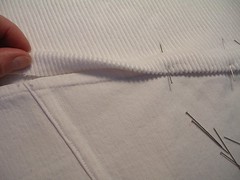
I am going to sew the yoke facing down from the outside or right side of the jacket so I make sure that the folded edge overlaps the seam by enough that I won’t fail to catch it in the topstitching. This excess means that I have a larger folded edge on the inside than if I sewed it from the inside, but it also means that my topstitching which will be only seen from the outside will look neat and tidy on the outside. Here’s what the yoke looks like from the inside:
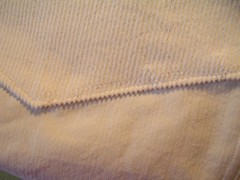
and here’s what it looks like on the outside after topstitching:
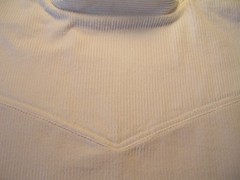
I also machine baste the yoke around the shoulders and down the front armhole in preparation for sewing the sleeves on, which comes next. Here is the jacket hanging up, before I put the sleeves on. It is starting to look like a real jacket!
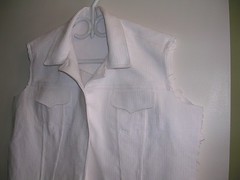
4 comments:
I really enjoyed your site. The step by step photos are terrific, and your instruction super-clear. I'll be coming back for sure!
Thanks Miriam and welcome to my blog.
Hi, I see you have started a Jeans jacket, well actually you are almost done. Funny enough, I have just recently been collecting patterns of Jeans jackets to compare them for shape and style. I have so far collected 2 in Burda's magazines and 1 as a pattern and 1 KwikSew.
I noticed you were turning down a seam to clean-finish the edges. What seam allowances are you using? I must have missed it at the beginning and am just too tired/lazy tonight to go back and read through.
I love the white cord. I purchased black cord and some red and green from Ressy's coop (Fabrics&Notions) over at the Yahoo.com
Three cheers for you.
Hi Anon, what patterns are you using? I looked for the right jeans jacket pattern for a while before I found this one from Vogue. I liked all the panels and pieces and except for the facings, it was like a commercially made jacket so that’s why I chose it.
I use the standard 5/8 inch seam allowance and trim off one side of it if I am making a proper flat felled seam finish.
I love corduroy too - anything 100% cotton.
Post a Comment